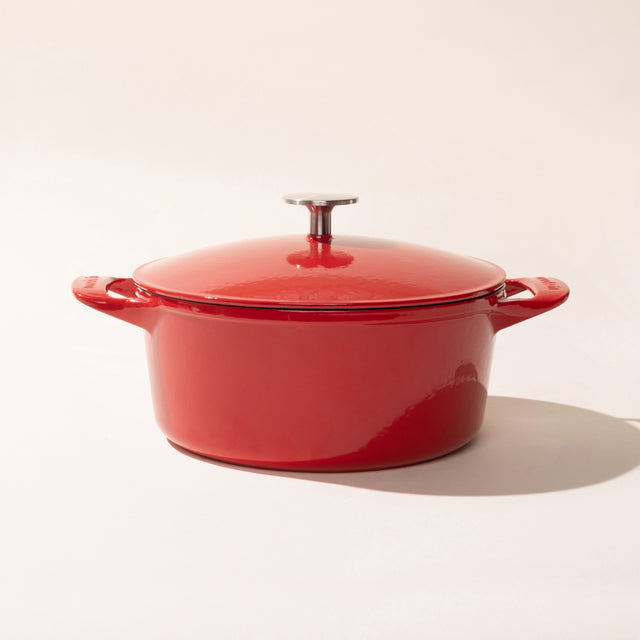




Keep your Dutch oven looking brand new with just a few simple cleaning tips.
Cooking is inherently messy—spills, burns and accidents happen. Cleaning up may not be the most enjoyable part of the cooking process, but it’s one of the most important, especially for heirloom cookware like our Enameled Cast Iron Dutch Oven.
Considering this is one of the most versatile pieces of cookware in the kitchen, it's important to know how to clean correctly so you can enjoy this workhorse kitchen tool for years to come.
Here, we'll break down several methods for cleaning your Dutch oven, from basic washing to what to do when things get seriously stuck.

No matter which cleaning method you choose, there are some crucial things to keep in mind as you clean your Dutch oven. The first is to be gentle—you don’t want to scratch the enamel, especially on the interior. For this reason, don't use abrasives like steel wool and instead, opt for a soft dish sponge or a scrub brush.
Second, when you’re finished cleaning, make sure you let the Dutch oven dry fully before storing it. After going to the trouble of carefully washing it, you don’t want your Dutch Oven to develop any rust. Both the lip of the pan and the lid are unfinished, exposing the cast iron core. To avoid rust, thoroughly dry with a dish towel. This will also prevent water-spotting on the enamel.
Keeping these things in mind, follow along with the steps below to properly clean your Dutch Oven, no matter what level of mess you’re dealing with.
Whether you’re braising, making soup, or cooking pasta, both the interior and exterior of your Dutch oven can get stained. Before cleaning any level of mess, allow your Dutch oven to cool thoroughly before placing it in the sink.
Step 1: Start by cleaning the exterior of your Dutch oven with hot, soapy water and your soft sponge.
Step 2: If this is a basic clean up, simply wash the Dutch Oven with dish soap, scrubbing as necessary.
Step 3: For more stubborn spots, allow your pan to soak in hot water with a couple drops of soap. Leave it for 15-20 minutes, allowing for the food to soften, then resume scrubbing.
For stains that just won’t budge, it’s time to get a little professional help. Either our Ceramic Cleaner (formulated for our Enameled Cast Iron, Bakeware, and Plateware) or Bar Keeper’s Friend are effective at removing stubborn stains, burns, or residue.
Ceramic Cleaner
To use our Ceramic Cleaner, shake the bottle well, then pour a small amount of cleaner onto the burn or stain. Rub it in with a sponge, then rinse. Repeat as needed until the stain, burn, or residue is gone.
Bar Keeper's Friend
You can use Bar Keeper’s Friend in two ways. For all over cleaning, simply sprinkle it over the bottom of the Dutch oven and scrub with a damp sponge.
If you’re dealing with tougher stains, mix with a small amount of water to form a paste, and let that sit on the affected area for up to 30 minutes, then continue to scrub as usual. You may need to repeat this process several times.
If you don’t have either cleaner handy, then baking soda is a good option that you likely already have in your pantry. You can use it just as you would Bar Keeper’s Friend and make a paste to help scrub away burnt bits, but it’s also good for heavy-duty stain removal when it looks like the surface of your Dutch oven is beyond repair.
Step 1: For the most stubborn messes, bring 4 cups of water to a boil, then add 2 tablespoons of baking soda.
Step 2: Let that fizz away for a few minutes, stirring gently with a Wooden Spoon. The ensuing reaction should cause caked on food to rise up from the bottom and as it softens, you can also scrape some up with the Wooden Spoon.
Step 3: Continue this process for about 5 minutes, then remove from heat and dump out the water.
Step 4: If any stains still remain, use the paste method.
Baking soda will leave some residue behind, so make sure you rise out your Dutch Oven one more time before you dry it.
Now that you know how to clean your Dutch oven, you can enjoy cooking in it with confidence. Remember, it’s a very durable piece of cookware, and even when stains look dire, it’s likely just a matter of elbow grease to get it looking good as new again.
Now that you know how to clean after even the messiest meal, try your hand at Chef Tracy Malechek-Ezekiel of Austin's Birdie’s Spaghetti Bolognese. It’s perfect for when you want a warm, meaty bowl of pasta and makes more than enough to feed a crowd. Any sauce drips or burnt bits can easily be cleaned using the methods outlined above.
We use cookies to provide a better user experience. By using our site, you agree to our use of cookies. See our Privacy Policy to learn more.